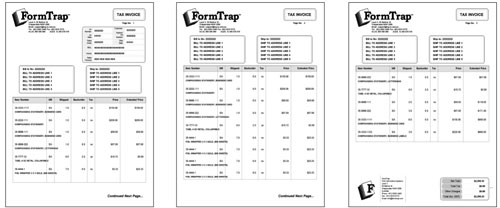
| Design and Objects |
 Designing a Static Form
Designing a Static Form |
 Designing a Dynamic Form
Designing a Dynamic Form
|
| Objects |
 Creating Objects
Creating Objects |
 Deleting Objects
Deleting Objects |
 Arranging Objects
Arranging Objects |
| Page Elements |
 Creating Page Elements
Creating Page Elements |
 Deleting Page Elements
Deleting Page Elements |
 Arranging Page Elements
Arranging Page Elements |
| Preview the Form |
 Preview the Form
Preview the Form |
| Designing a Dynamic Form |
|
|
A Dynamic form is more flexible but also more complex to design. Use a Dynamic form for long documents where you require more details per page and/or "C/Fwd" amounts on intermediate pages. In this mode, Page headers may have less detail on pages after the first page of a document, and more space is left on the final page to carry trailer details. The design process for creating a dynamic form harnesses many of the advanced features of FormTrap. A dynamic form is one on which the framework is not fixed, but will print in different positions according to the size of headers and footers. Little is defined on the Base page and the area in which details print will also be defined dynamically page to page as the form is printed. A dynamic form is characterized by:
|
|

